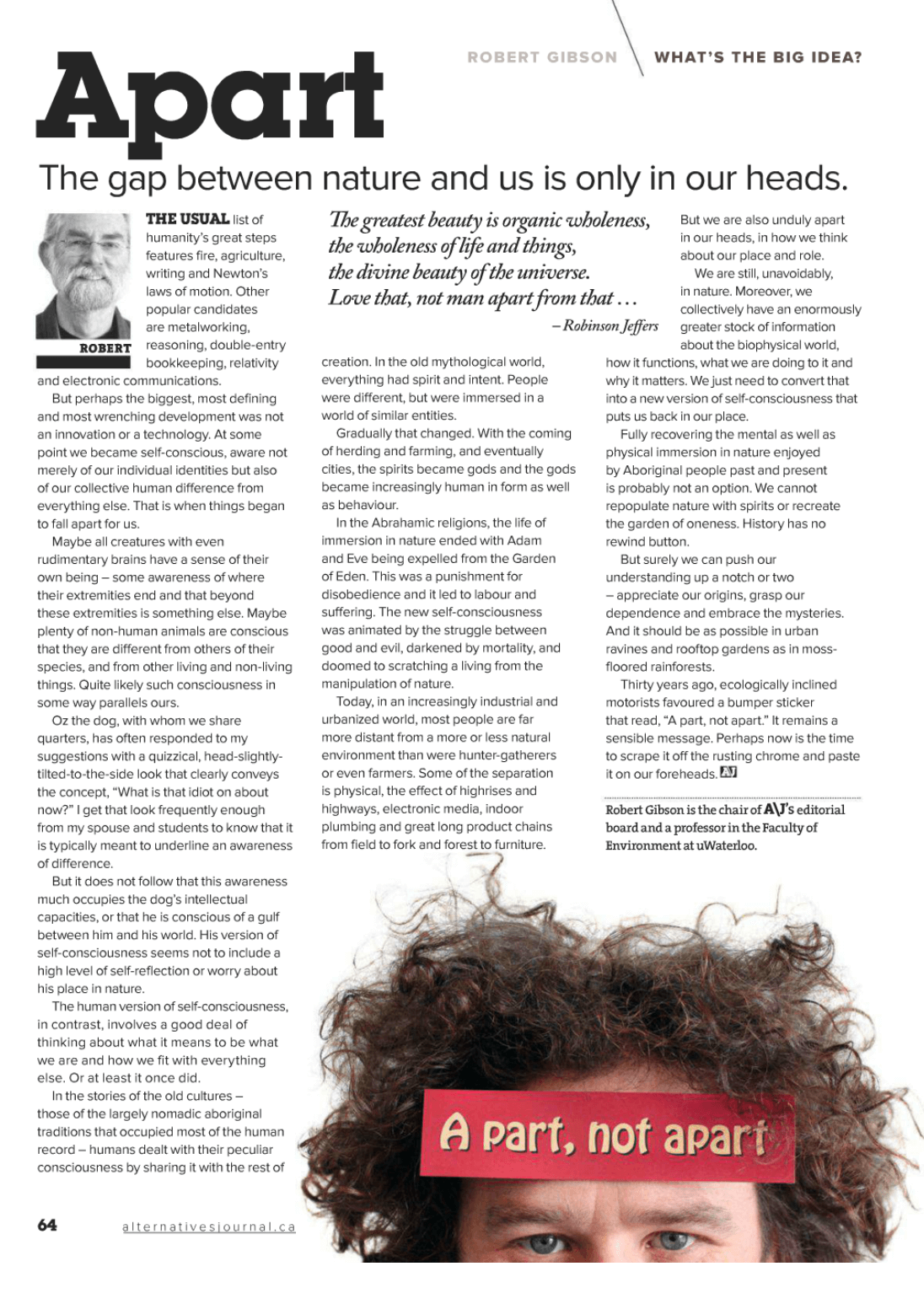
What’s the Big Idea is a semi-regular column in Alternatives Journal. The ideas are all in some way relevant to the pursuit of sustainability in a complex world.
Balance (.pdf): Good for trapeze artists and beer drinkers, seeking balance won’t lead us to a more desirable and durable future. Alternatives Journal 36:1 (2010), p.40.
Simplicity (.pdf): Sounds good if you don’t mind a dollop of ignorance with your bliss. Alternatives Journal 36:2 (2010), p.40.
Markets (.pdf): The market system is powerful, necessary and stupid. You want to have it on your side, but you would be crazy to let it run things. Alternatives Journal 36:4 (2010), p.40.
Substitution: Substitution gets us genetic engineering, nuclear reactors ocean draggers and unconventional oil. Alternatives Journal 36:6 (2010), p.46.
Bullshit (.pdf): Disrespect for the concept of truth erodes the foundations of any worthy culture. Alternatives Journal 37:1 (2010), p.40.
Non-renewable (.pdf): “My grandfather rode a camel. My father rode in a car. I fly in a jet airplane. My grandson will ride a camel.” (alleged Saudi saying) Alternatives Journal 37:2 (2011), p.40.
Evolution (.pdf): The nature of human origins is less important than the origins of human nature. Alternatives Journal 37:4 (2011), p.40.
Ethics (.pdf): How we value species at risk is ever more important on a stressed planet. Alternatives Journal 37:5 (2011), p.48.
Co-evolution (.pdf):Not much happens by itself. Alternatives Journal 38:1 (2011), p.48.
Mitigation (.pdf): Less bad is no longer good enough. Alternatives Journal 38:2 (2012), p.40.
Community (.pdf): All of us have the guts to admit our co-dependents. Alternatives Journal 38:4 (2012), p.48.
Denial (.pdf): Why the powerful and the desperate ignore the No Exit signs. Alternatives Journal 38:5 (2012), p.48.
Allies (.pdf): It’s simply not true that everyone is either part of the solution or part of the problem. Alternatives Journal 38:6 (2012), p.64.
Debt (.pdf): Tapped out consumers, bankrupt nations and our poor battered biosphere have much in common. Alternatives Journal 39.1 (2013), p.64.
Advertising (.pdf): Marketing gurus know their target audiences are not natural consumers. Alternatives Journal 39.2 (2013), p.64.
Opinion (.pdf): There’s a big difference between telling us what to believe and reporting what we need to know. Alternatives Journal 39.3 (2013), p.64.
Spectrum (.pdf): Political colours were originally based on blood. Adding chlorophyll changes things. Alternatives Journal 39.4 (2013), p.64.
Natural (.pdf): How would Mother Nature run the economy? Alternatives Journal 39.6 (2013), p.64.
Apart (.pdf): The gap between nature and us is only in our heads.Alternatives Journal 40.1 (2014), p.64.
Kuznets (.pdf): The great economist’s beguiling curves have not aged well. Alternatives Journal 40.2 (2014), p.64.
Weeds (.pdf): Humans can continue as the planet’s most successful weeds, but only if we stop wrecking the place. Alternatives Journal 40.4 (2014), p.64.
Science (.pdf): Reliable understanding does not always require lab coats, calculus and controlled conditions. Alternatives Journal 40.5 (2014), p.64.
Hubris (.pdf): Napoleon paid for his. Ours looms. Alternatives Journal 41.2 (2015), p.64.
Status (.pdf): Humans are competing with moose for the least sensible path to social recognition. Alternatives Journal 41.3 (2015), p.64.
Conflict (.pdf): The things that connect us should be more interesting than those that divide,” (Column, What’s the Big Idea?), Alternatives Journal 41.4 (2015), p.64.
Small (.pdf): Tiny creatures may be beautiful or ugly, but mostly they are neglected,” (Column, What’s the Big Idea?), Alternatives Journal 41.5 (2015), p.64.